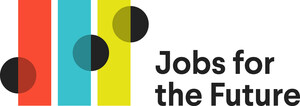Students at the Center Project Explores How Students Learn Best—
Reports on Enhancing Literacy and on Math Instruction for Minorities also Released
BOSTON, March 28, 2012 /PRNewswire-USNewswire/ -- New educational technologies offer exciting ways to help teachers adapt classrooms to the interests, needs, and strengths of individual students, but they cannot replace the crucial creative and emotional work of teachers, according to a new research paper from the ambitious interdisciplinary project, Students at the Center: Teaching and Learning in the Era of the Common Core. Curricular Opportunities in the Digital Age is one of three papers Jobs for the Future released today, with funds from the Nellie Mae Education Foundation, to focus attention on putting middle and high school students at the center of education reform strategies in order to significantly raise U.S. educational achievement, increase completion rates, and help close persistent race and income gaps.
(Logo: http://photos.prnewswire.com/prnh/20120314/DC69816LOGO)
The two other papers released today – Literacy Practices for African-American Male Adolescents and Latino/a and Black Students and Mathematics – also find that student-centered approaches to learning have great potential to improve the literacy and math skills of adolescents from underserved minority groups, but do so most effectively if the curriculum has a connection with students' lived experience in families and communities. These papers, like that on technology, show that students learn best when schooling builds on the identities they bring to the classroom.
Student-centered approaches to learning reject the one-size-fits-all instruction that can result from pressure to increase student scores on standardized tests. But they do not lower standards or ignore them. Rather, student-centered practices help teachers connect meaningfully with their students and individualize instruction to each, while also taking advantage of the social aspects of learning—adolescents' propensities to collaborate with their peers. Capitalizing on the adaptability of the brain, student-centered approaches start from the premise that all students can learn when provided with instruction that truly engages them and adapts to their changing needs. All young people can acquire the skills, knowledge, and expertise needed for 21st-century college and career success. These include and go beyond the Common Core State Standards.
"We believe the papers written for Students at the Center will contribute to the efforts of states to prepare educators of adolescents for deeper learning," said Nancy Hoffman, vice president at Jobs for the Future. "However promising the Common Core State Standards, students and their teachers must be engaged and motivated learners. If they are not, this enormous and expensive undertaking will be no more successful than previous efforts in the standards movement."
In addition to the research papers, the website of the Students at the Center project contains a searchable resource database that will be expanded on an ongoing basis. It includes videos, websites, and external research papers that have been gathered by the papers' authors and the larger student-centered learning community to enhance the usefulness of this knowledge base.
The first group of papers was released March 14. The final group of papers will be released April 11. On April 25-26, an invited group of education researchers, writers, practitioners, and policymakers will attend a symposium to further identify how student-centered approaches to learning can be implemented at the district, state, and national levels to further the goals of education reform and to align with the Common Core standards.
Following is an overview of the papers released today. Executive Summaries are available HERE. The full papers can be downloaded HERE.
Curricular Opportunities in the Digital Age
By David Rose and Jenna Gravel
This paper explores how educators can use new technologies to design curricula that address the wide range of individual differences in any classroom, providing a foundation for student-centered, rather than curriculum-centered, approaches to teaching and learning. The authors note that digital technologies provide supportive tools that can enhance a teacher's abilities, but they caution that technology has clear limits, too. Of prime importance, digital technologies are not good at the "emotional work" of the classroom, which is ultimately about building and enhancing relationships between teachers and students.
Curricular Opportunities in the Digital Age includes these key findings:
- Advances in neuroscience reveal that the brain is highly differentiated and specialized, with a mind-boggling array of strengths and weaknesses – within individuals, as well as among different people.
- Multimedia technologies provide an encouraging foundation for student-centered learning, offering educators the ability to customize how and what we teach each student in each subject.
- Student-centered classrooms can harness the flexibility of new media to provide a diverse range of students with the multiple means of representation, expression, and engagement each needs to become a thoughtful, strategic, and motivated learner.
Literacy Practices for African-American Male Adolescents
By Alfred W. Tatum
The author takes a fresh, cross-disciplinary approach to the stubbornly low literacy performance of African-American males, noting how current school literacy practices and policies are overly generic and miss the mark. Placing student-centered learning in the context of race and gender, this paper reviews literature on factors that impede reading achievement, provides a socio-historical perspective for advancing African-American male literacy, proposes a framework of literacy instruction, and discusses implications for research, policy, and practice.
Literacy Practices for African-American Male Adolescents includes these key findings:
- Many urban school districts responding to federal mandates have failed to yield improvement in the reading achievement of young African-American males.
- An appropriate approach takes into account that instructional, socio-cultural, and personal factors likely combine to determine success or failure.
- Student-centered approaches to learning are a promising pathway for advancing African-American male literacy development because they have the potential to boost internal and external protective resources.
- Understanding the roles reading and writing played for African-American males historically serves as a productive starting point for preparing curricula.
Latino/a and Black Students and Mathematics
By Rochelle Gutierrez and Sonya E. Irving
Using new perspectives on mathematics as a cultural and social activity, combined with research on learning outside of school, this paper provides student-centered approaches for reducing the mathematics "achievement gap."
Latino/a and Black Students and Mathematics includes these key findings:
- Mathematics taught in U.S. schools is not the only mathematics that people use. Different cultures practice different types of math, and bringing these perspectives into the classroom can engage a broader audience of students in learning math.
- How students feel about themselves while doing mathematics is critical to how much they engage with it. Out-of-school experiences can help a person develop confidence, a larger repertoire of math strategies, and a math identity built upon his or her culture or community—all of which contribute to school learning.
- Small-group learning, which is more common in afterschool programs than in regular classrooms, provides more opportunities for students to explain their thinking, get feedback quickly, and refine their thinking based on a variety of perspectives.
About Jobs for the Future
Jobs for the Future identifies, develops, and promotes new education and workforce strategies that help communities, states, and the nation compete in a global economy. In over 200 communities in 43 states, JFF improves the pathways leading from high school to college to family-sustaining careers.
www.jff.org
www.twitter.com/JFFtweets
About Nellie Mae Education Foundation
The Nellie Mae Education Foundation is the largest charitable organization in New England that focuses exclusively on education. The Foundation supports the promotion and integration of student-centered approaches to learning at the middle and high school levels across New England. To elevate student-centered approaches, the Foundation utilizes a strategy that focuses on: developing and enhancing models of practice; reshaping education policies; increasing the body of evidenced-based knowledge about student-centered approaches and increasing public understanding and demand for high quality educational experiences. The Foundation's initiative and strategy areas are: District Level Systems Change; State Level Systems Change; Research and Development; and Public Understanding. Since 1998, the Foundation has distributed over $110 million in grants. www.nmefoundation.org
About Students at the Center
Students at the Center synthesizes existing research on key components of student-centered approaches to learning. The papers that launch this project renew attention to the importance of engaging each student in acquiring the skills, knowledge, and expertise needed for success in college and a career. Students at the Center is supported generously by funds from the Nellie Mae Education Foundation.
www.studentsatthecenter.org
www.facebook.com/StudentsattheCenter
SOURCE Jobs for the Future
WANT YOUR COMPANY'S NEWS FEATURED ON PRNEWSWIRE.COM?
Newsrooms &
Influencers
Digital Media
Outlets
Journalists
Opted In






Share this article